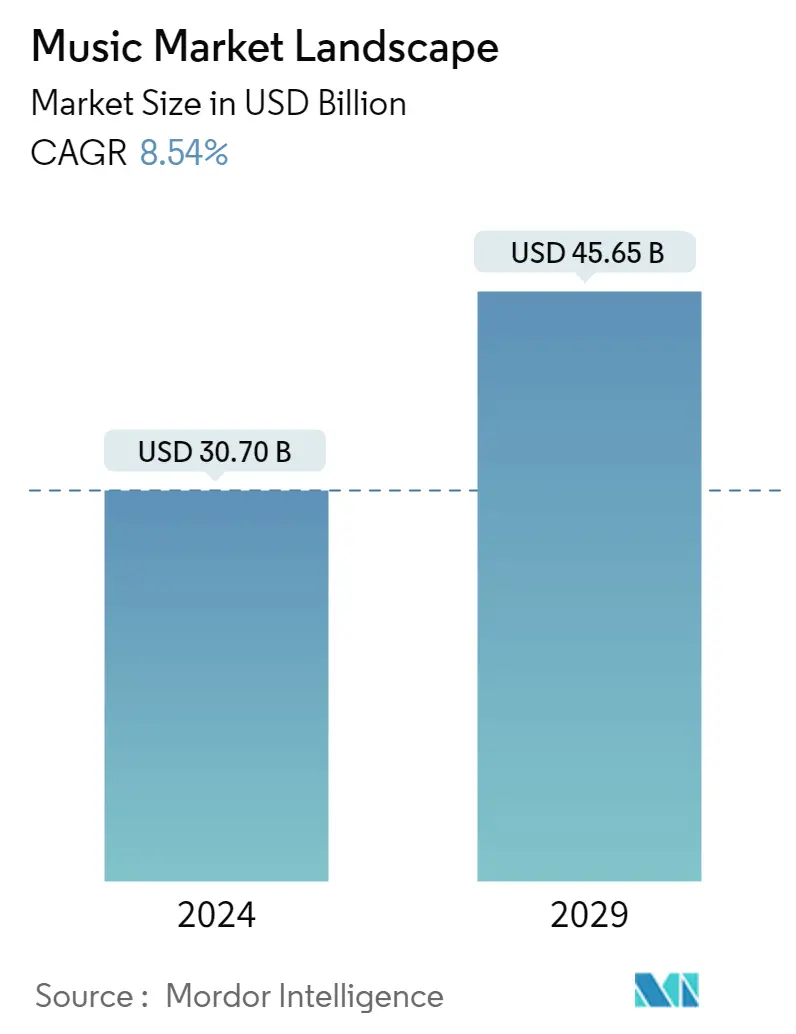Market Size of Music Industry Landscape

| Study Period | 2019 - 2029 |
| Market Size (2024) | USD 30.70 Billion |
| Market Size (2029) | USD 45.65 Billion |
| CAGR (2024 - 2029) | 8.54 % |
| Fastest Growing Market | Asia-Pacific |
| Largest Market | North America |
Major Players
*Disclaimer: Major Players sorted in no particular order |
Music Market Analysis
The Music Market size is estimated at USD 30.70 billion in 2024, and is expected to reach USD 45.65 billion by 2029, growing at a CAGR of 8.54% during the forecast period (2024-2029).
- The music industry has reached a new level of internationalization. The international music community has never been more connected, and fans and artists alike are seizing the opportunities of this new era to enjoy and share the music they love.
- Throughout the projected period, it is anticipated that the use of intelligent devices will increase along with the increased penetration of digital platforms. Music streaming services include websites that let users watch music videos, listen to audio, and subscribe to podcasts. Due to functions like automatic playlist customization, song recommendations, and hassle-free connectivity on apps and browsers, these platforms are becoming more and more popular. Additionally, these portals' expanding podcast genres fuel the market's expansion.
- Online and social media platforms such as YouTube have allowed aspiring artists to showcase and present their work to the world. After Google, the site is the second most popular social media platform. The music market is significantly growing in Asia and Latin America, as artists are actively seizing the opportunities to break out to a global audience.
- Additionally, recording companies are investing extensively in music artists, with record labels being the largest investors in the music ecosystem. According to the IFPI, record labels invest over US$ 5.8 billion in artists yearly through Artists & Repertoire (A&R) and marketing worldwide. Such an investment increase is expected to continue in the forecast period, estimated to drive the music market's growth.
- As the market expands and artists seize the digital generation opportunity, music foundations are making efforts to be in a position to support their long-term development with sustainability.
- The COVID-19 outbreak forced lockdowns in most nations to stop the virus from spreading. Due to this, music streaming services like Spotify, Tencent Music Entertainment, and Amazon Music saw increased subscriber numbers. Moreover, there was a rise in subscribers using live streaming on websites like YouTube and Instagram. Video content was already streamed more frequently than audio content in the United States. However, the pandemic greatly increased its appeal. Therefore, COVID-19 significantly helped the growth of the music streaming sector.
Music Industry Segmentation
The music industry comprises the people and businesses that make money by writing songs and other musical works, producing and marketing recorded music and sheet music, and staging concerts, as well as the agencies that support, educate, advocate for, and provide music makers.
The Music Market Landscape is divided into Revenue Generation Formats (Streaming, Digital (except streaming), Physical Products, Performance Rights, and Synchronization Revenues) and Geographies (North America (United States, Canada), Europe (Germany, United Kingdom, France, Italy, and Rest of Europe), Asia Pacific (India, China, Japan, South Korea, and Rest of Asia-Pacific), Latin America (Brazil, Mexico, and Rest of Latin America), and the Middle East and Africa).
The market sizes and forecasts are provided in terms of value in USD for all the above segments.
| Revenue Generation Format | |
| Streaming | |
| Digital (Except Streaming) | |
| Physical Products | |
| Performance Rights | |
| Synchronization Revenues |
| Geography | |||||||
| |||||||
| |||||||
| |||||||
| |||||||
| Middle East and Africa |
Music Market Landscape Size Summary
The music market is experiencing significant growth, driven by the increasing internationalization and digitalization of the industry. The rise of intelligent devices and the penetration of digital platforms have transformed how music is consumed, with streaming services gaining immense popularity due to features like personalized playlists and seamless connectivity. Platforms such as YouTube, Spotify, and Apple Music are at the forefront, enabling artists to reach global audiences and allowing fans to access a vast array of music and podcasts. The COVID-19 pandemic further accelerated this trend, as lockdowns led to a surge in subscribers for music streaming services and increased engagement with video content. The market is also witnessing substantial investments from record labels in artists, which is expected to continue driving growth.
In regions like Asia and Latin America, the music market is expanding rapidly as artists leverage digital platforms to reach wider audiences. The United States remains a key player, with a robust increase in paid subscriptions and strategic competition among streaming services. Companies are forming strategic alliances and investing in advanced technologies to enhance their offerings. The market is moderately consolidated, with major companies like UMG and Sony Music dominating the recording services sector. Ongoing collaborations and strategic agreements, such as those between Downtown Music Publishing and Outer Voice Music Publishing, are aimed at promoting diverse music catalogs and expanding global reach. These developments, along with the continuous evolution of digital platforms, are poised to sustain the market's growth trajectory in the coming years.
Music Market Landscape Market Size - Table of Contents
-
1. MARKET INSIGHTS
-
1.1 Market Overview
-
1.2 Industry Stakeholder Analysis
-
1.3 Industry Attractiveness - Porter's Five Forces Analysis
-
1.3.1 Bargaining Power of Suppliers
-
1.3.2 Bargaining Power of Consumers
-
1.3.3 Threat of New Entrants
-
1.3.4 Threat of Substitute Products
-
1.3.5 Intensity of Competitive Rivalry
-
-
-
2. MARKET SEGMENTATION
-
2.1 Revenue Generation Format
-
2.1.1 Streaming
-
2.1.2 Digital (Except Streaming)
-
2.1.3 Physical Products
-
2.1.4 Performance Rights
-
2.1.5 Synchronization Revenues
-
-
2.2 Geography
-
2.2.1 North America
-
2.2.1.1 US
-
2.2.1.2 Canada
-
-
2.2.2 Europe
-
2.2.2.1 Germany
-
2.2.2.2 UK
-
2.2.2.3 France
-
2.2.2.4 Italy
-
2.2.2.5 Rest of Europe
-
-
2.2.3 Asia-Pacific
-
2.2.3.1 India
-
2.2.3.2 China
-
2.2.3.3 Japan
-
2.2.3.4 South Korea
-
2.2.3.5 Rest of Asia-Pacific
-
-
2.2.4 Latin America
-
2.2.4.1 Brazil
-
2.2.4.2 Mexico
-
2.2.4.3 Rest of Latin America
-
-
2.2.5 Middle East and Africa
-
-
Music Market Landscape Market Size FAQs
How big is the Music Market?
The Music Market size is expected to reach USD 30.70 billion in 2024 and grow at a CAGR of 8.54% to reach USD 45.65 billion by 2029.
What is the current Music Market size?
In 2024, the Music Market size is expected to reach USD 30.70 billion.

